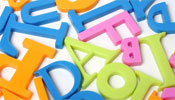 Teacher
Guide to Learning Letters and Sounds
Teacher
Guide to Learning Letters and Sounds
Introducing children to letters and sounds can be as easy as singing a song. You know which one I'm talking about, the alphabet song is a tried and true standard for teaching toddlers the alphabet and the beginning sounds. Sing alongs really don't get the recoginition they deserve in the education landscape. That goes hand and hand with coloring. Do you realize how great coloring skills translate to penmanship. I am a big believer in both singing and coloring. Come to my classroom and you'll see it in action.
Scores of Alphabet Songs
But did you know there are other songs? Phonic songs and songs set to YouTube video's and, well if you Google alphabet songs you'll end up with over 800,000 hits. My two year old grandson is a big fan of YouTube videos and the preschool songs that are available. He has even figured out how to turn the volume up on my laptop and is able to hit replay. And he's an alphabet song virtuoso.
Read-Out-Loud
You learn sounds and letters by hearing and seeing them. Reading out loud to a child can be a strong influence on them learning their letters and sounds. Pick rhyming alphabet books and silly selections like those from Dr. Seuss. As you are reading to them and say something like a is for apple, a... a... a... make sure and point at the letter a and have the child mimic your words.
Change up some of the books, but make sure to continue to re-read specific favorites and you may find that as the child grows older; they'll be pointing at the book and "reading" it to you before they are really able to read the words. That's right, they will have memorized it. With any learning, repetition is key. This is especially true with introducing a child to their letters and sound.
This is also a good time to research all those old tongue-twisters and repeat them to the kids. You know:
Fuzzy Wuzzy was a bear,
Fuzzy Wuzzy had no hair,
Fuzzy Wuzzy wasn't very fuzzy, was he?
How many other ways are they going to be able to practice the sound of z? Once you say these little ditties, you'll end up repeating yourself a hundred times until the child gets it right and memorizes it. But they will be practicing their sounds. For the best of both worlds, get them to practice writing or coloring their Zs while they are singing. Magnetic Letters I'm a big fan of magnetic letters. The bottom half of my fridge is covered in them I have several different sizes and both lower and upper case letters. My six year old grandson delights in writing his name and spelling the words he's learned in school this week. My two year old grandson and daughter come in the door and make a bee-line for the fridge and have to be enticed into my lap with a treat. Otherwise they'd be playing with the "Yetters" the entire time they're at my house.
L's a big one right now. We search the house for L words and practice touching our tongues to our top teeth as we continue to repeat the sound. But the point is, the magnetic letters aren't work, they are fun. And yet I can guarantee I'll spend an hour every time one of the grandchildren come over, making up silly words and trying to pronounce them with the sounds each letter makes. If you can get a child to practice their letters and sounds, then the introduction is over and you'll soon be moving on to perfection.